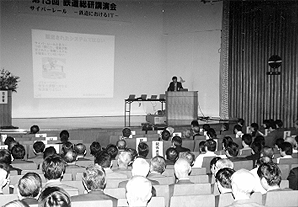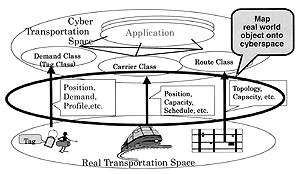
Fig.1 General Lecture

Fig.2 Image of CyberRail
The Lecture Conference of the Railway Technical Research Institute is designed to be held once every year, and is open to the public. This year we held the thirteenth conference with the theme of "Information Technology for the CyberRail", where we considered railway transportation at the beginning of the 21st century, looking at Information Technology and discussing in what fields we can expect the development of such technologies. The conference was held at Yamaha Hall (in Tokyo). Approximately 450 members participated, mainly from JR, private railways and railway-related firms. In this paper, we summarize the lectures presented at the conference, with the titles of lectures and names of lecturers.
Special lecture : "IT and Transport" (Dr. Eisuke Masada, professor at Science University@of Tokyo)
Along with the progress of information communication, we are entering an age where modern conveniences will make people's lives better, through the development of various means, including satellite communication, internets and mobile terminals. We know that there is a good possibility of making great strides in the transportation field by fusing information technologies recently developed and the needs of users. The lecturer introduced the possibilities IT may bring about in the transportation field from the following two viewpoints: improvement of mobility and realization of an integrated transportation system. His talk, first of all, referred to a community between information networks and transportation networks, and he said it was possible to provide information in real time by constructing an information network supporting transportation. He also said this would contribute greatly to improvement of mobility in emergencies. He predicted this technology would be able to make intermodal transport easier, and therefore, the transportation system itself may become a new comprehensive service industry, with lesser impact on the environment and improved safety and convenience.
Utilization of IT in railway transportation businesses (Yasuo Sato, Director)
Utilization of ITs in the railway sector has already a long history especially in the development of seat-reservation systems since the 1960s. The people in this field are developing a wide range of activities for IT-based projects. The lecturer proposed a new image of CyberRail with the concept of an integration of various ITS and presented a tremendous potential to provide users of the information on how to use seamless and barrier-free railways. To create a reliable CyberRail, he emphasized the necessity of solving various problems we currently face, including realization of a large scale public IT infrastructure, improvement of convenience for users in money settlement, and realization of a railway facilities easy to use for the elderly and the disabled.
CyberRail system (Takahiko Ogino, Information & International Affairs Division)
ITS, particularly identified in Japan as information and control systems for road transportation to improve safety and efficiency, has been developed in the area of automobile and motorway transport so far. CyberRail is considered as a counterpart system for ITS from a railway side.
At the presentation, a comparison between IT functions and railway related IT applications currently available was given. Railway systems are superior to ITS as far as safety operations and automatic fare collection systems are concerned, although the former has problems about providing information and guidance to passengers. It is argued that ITS and CyberRail however, do not oppose each other, rather should cooperate to improve convenience and mobility through a seamless and barrier-free intermodal transport, from a passenger point of view. Scenes in a CyberRail world, concrete images of CyberRail, were presented and it was emphasized that the locations and status of travelers or parcels during transport in a real world, are key information for CyberRail. By keeping a one to one correspondence between a real passenger and a virtual passenger on a cyber space, we could provide any travel related information and save labor of ticketing and related background jobs. This could bring a new business model to transportation companies. A model and an interface of CyberRail were presented and the importance of making system architecture was mentioned as well.


Fig.2 Image of CyberRail
Services to users of CyberRail (Tsuchiya Ryuji, Transport Information Technology Division)
As starting point for creating a specific CyberRail concept, Mr. Tsuchiya started his discussion from the introduction of services of CyberRail to users, presenting four key-points: providing information and guidance, distribution and management of railway-related information, drafting of a transportation plan and providing of high level functions, and intelligent train control. The speaker, regarding measures for responding to the demands from users (for example, to reach a destination more rapidly), specifically discussed what kinds of functions or systems are needed over the itinerary guidance and operation of trains. He insisted that when requested to decide whether it was necessary to provide a system architecture integrating these functions or not, we would need to take a careful attitude by grasping trends of IT systems clearly.
Implementation methods of CyberRail (Kiyotaka Seki, Signaling & Telecommunications Technology Division)
As introduction, the speaker reported there were some technologies and methods to realize CyberRails, responding to services to users that can be assumed from the potential of CyberRails. The gist of the lecture was that in order to realize CyberRails, it is necessary to provide communications means to a Cyber space, highly precise positional detection and identification of individuals, user interface with functionally sophisticated terminals, creation of a user platform for information distribution, protection of privacy, algorithm and software necessary for realizing a system, and a high performance detection system of obstacles. As implementation methods, he stated that we need to develop not only a public mobile communication, but also a system able to more accurately detect positions in the station premises and the trains.
CyberRail Facilities (Toshiyuki Aoki, Structures Technology Division)
Creation of a CyberRail will enable us to make our movement the smoothest we have ever experienced as railway users, but for this purpose, the speaker insisted it was necessary to provide railway facilities able to demonstrate the maximum effect CyberRail may have. His lecture referred to the absolute necessity of infusion with ITS for intermodality with other transport means, and he pointed out that it is essential to guide users by providing correct information on arrival time and the time needed to switch to another transport means. Within the premises of a station, it is advisable to install a gateless system using no tickets (please note that all railway stations in Japan have ticket gates) and a guide system of trains. The structure of a station should be remodeled to meet the requirements as a CyberRail Station.
Experiment of a CyberRail (Takashi Watanabe, Information System of JR Railway Technical Research Institute)
An experimental prototype of a CyberRail-based navigation system was implemented in the lecture hall, using Bluetooth, a short distance wireless communication standard. In the experiment, the case used is that a virtual user bearing a mobile terminal goes to his home in the suburb, from a station in the center of Tokyo. The experiment revealed that the user could know various kinds of information through the mobile terminal, including at what station the user need to change trains, when he would arrive at the destination. Even in case of an accident involving disturbances in the time diagram, it was demonstrated that the system could successfully navigate the user in using an alternative route and in knowing his approximate arrival time at the destination.
Traffic technology in the era of IT revolution in the 21st century (Takashi Yamao, Transport Policy Bureau, Ministry of Transport )
In 1999, the Ministry of Transport (current Ministry of Land, Infrastructure and Transport) started a discussion group to deliberate new traffic and transport technologies in 2000s, studying ideal status of these technologies in the coming century. . At the lecture, the speaker introduced themes for said group, which included traffic intelligence, environmentally friendly traffic and transportation technologies. He insisted introduction of IT is indispensable to realize the concept. The results of discussions at the group titled "Strategy of Traffic and Transportation Technologies in the 21st century" were formally reported, in December from the Transport Technology Deliberation Council of the Ministry of Transport.